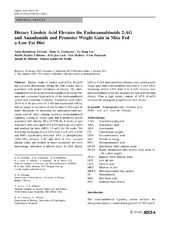| dc.contributor.author | Alvheim, Anita Røyneberg | en_US |
| dc.contributor.author | Torstensen, Bente Elisabeth | en_US |
| dc.contributor.author | Lin, Yu Hong | en_US |
| dc.contributor.author | Lillefosse, Haldis Haukås | en_US |
| dc.contributor.author | Lock, Erik-Jan | en_US |
| dc.contributor.author | Madsen, Lise | en_US |
| dc.contributor.author | Frøyland, Livar | en_US |
| dc.contributor.author | Hibbeln, Joseph R. | en_US |
| dc.contributor.author | Malde, Marian Kjellevold | en_US |
| dc.date.accessioned | 2015-03-23T13:47:10Z | |
| dc.date.available | 2015-03-23T13:47:10Z | |
| dc.date.issued | 2014-01 | eng |
| dc.identifier.issn | 0024-4201 | |
| dc.identifier.uri | https://hdl.handle.net/1956/9616 | |
| dc.description.abstract | Dietary intake of linoleic acid (LNA, 18:2n-6) has increased dramatically during the 20th century and is associated with greater prevalence of obesity. The endocannabinoid system is involved in regulation of energy balance and a sustained hyperactivity of the endocannabinoid system may contribute to obesity. Arachidonic acid (ARA, 20:4n-6) is the precursor for 2-AG and anandamide (AEA), and we sought to determine if low fat diets (LFD) could be made obesogenic by increasing the endocannabinoid precursor pool of ARA, causing excessive endocannabinoid signaling leading to weight gain and a metabolic profile associated with obesity. Mice (C57BL/6j, 6 weeks of age) were fed 1 en% LNA and 8 en% LNA in low fat (12.5 en%) and medium fat diets (MFD, 35 en%) for 16 weeks. We found that increasing dietary LNA from 1 to 8 en% in LFD and MFD significantly increased ARA in phospholipids (ARA–PL), elevated 2-AG and AEA in liver, elevated plasma leptin, and resulted in larger adipocytes and more macrophage infiltration in adipose tissue. In LFD, dietary LNA of 8 en% increased feed efficiency and caused greater weight gain than in an isocaloric reduction to 1 en% LNA. Increasing dietary LNA from 1 to 8 en% elevates liver endocannabinoid levels and increases the risk of developing obesity. Thus a high dietary content of LNA (8 en%) increases the adipogenic properties of a low fat diet. | en_US |
| dc.language.iso | eng | eng |
| dc.publisher | Springer | eng |
| dc.rights | Attribution CC BY | eng |
| dc.rights.uri | http://creativecommons.org/licenses/by/4.0 | eng |
| dc.subject | Endocannabinoids | eng |
| dc.subject | Linoleic acid | eng |
| dc.subject | PUFA | eng |
| dc.subject | n-6 | eng |
| dc.subject | n-3 | eng |
| dc.subject | Low fat | eng |
| dc.subject | Obesity | eng |
| dc.title | Dietary linoleic acid elevates the endocannabinoids 2-AG and anandamide and promotes weight gain in mice fed a low fat diet | en_US |
| dc.type | Peer reviewed | |
| dc.type | Journal article | |
| dc.date.updated | 2015-03-05T07:55:14Z | en_US |
| dc.description.version | publishedVersion | en_US |
| dc.rights.holder | Copyright 2014 The Authors | |
| dc.identifier.doi | https://doi.org/10.1007/s11745-013-3842-y | |
| dc.identifier.cristin | 1126869 | |
| dc.source.journal | Lipids | |
| dc.source.40 | 49 | |
| dc.source.14 | 1 | |
| dc.source.pagenumber | 59-69 | |
| dc.subject.nsi | VDP::Medical sciences: 700::Health sciences: 800::Nutrition: 811 | eng |
| dc.subject.nsi | VDP::Medisinske fag: 700::Helsefag: 800::Ernæring: 811 | nob |

